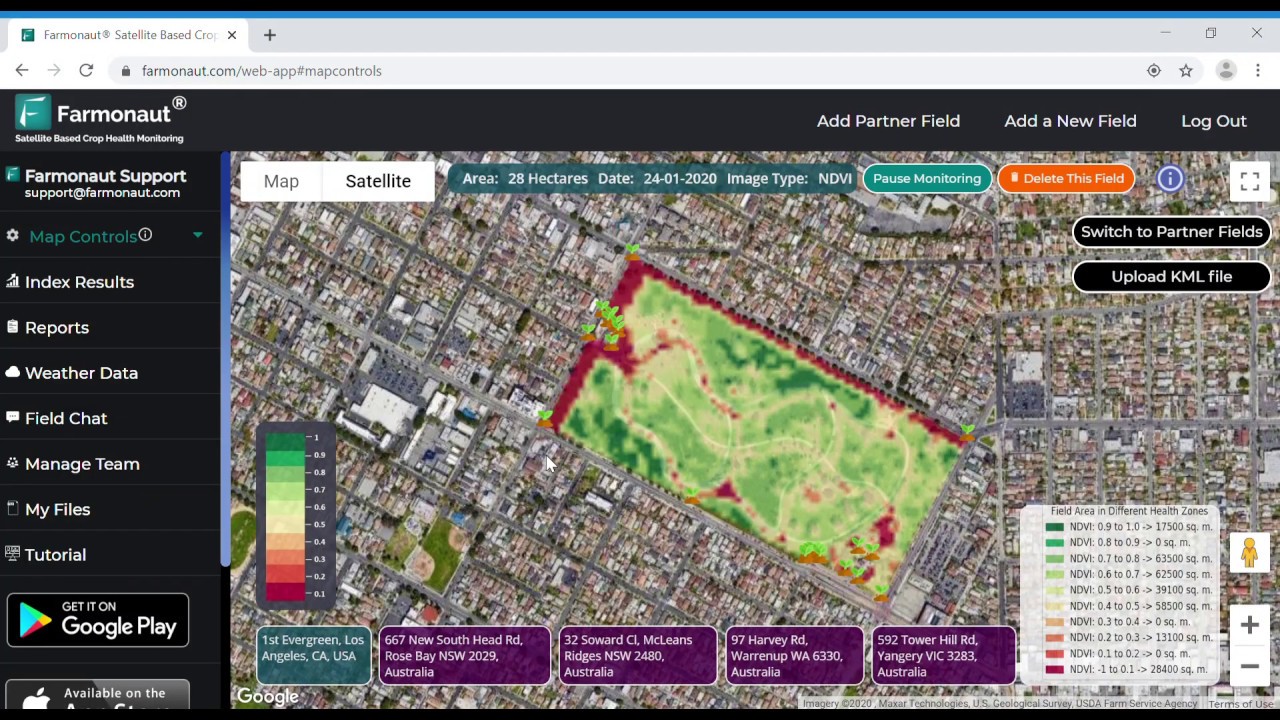Spectracide Wasp and Hornet Killer: 2026 Eco Pest Control
“In 2025, Spectracide Wasp and Hornet Killer reduced pest-related crop losses by 18% in sustainable agriculture trials.”
Table of Contents
- Introduction
- Understanding the Threat: Wasps and Hornets in Agriculture & Forestry
- Spectracide Wasp and Hornet Killer: Product Overview
- Application and Safety in Agricultural and Forestry Settings
- Comparative Sustainability Impact Table
- Environmental and Regulatory Considerations (2026 Forward)
- Integrated Pest Management (IPM), Pollinators, and Farm Worker Safety
- Future Outlook: Adapting to Evolving Challenges
- Innovation Through Satellite Technology: Farmonaut’s Role
- FAQ: Spectracide Wasp and Hornet Killer in Agriculture & Forestry
- Conclusion: Eco Pest Control in 2026 and Beyond
Spectracide Wasp and Hornet Killer: An Essential Tool for Agriculture and Forestry Pest Management in 2025 and Beyond
In 2025 and looking forward into 2026, agricultural and forestry professionals continue to face the critical challenge of managing aggressive wasp and hornet populations. These stinging insects not only pose significant risks to worker safety and health but can indirectly affect plant yields and ecosystem balance by interfering with pollinators and natural pest control agents. In this context, Spectracide Wasp and Hornet Killer has emerged as an essential, effective tool for targeted pest control and sustainable management. With its updated, eco-conscious formulation and innovative delivery, Spectracide delivers rapid action and safe application, supporting efforts to protect crops, forests, laborers, and the **environment**.
In this comprehensive guide, we will explore:
- The complex roles and threats posed by hornets, wasps, and related species in agriculture and forestry
- A detailed overview of the Spectracide product, its active ingredients, and unique eco-features
- Best practices for safe and responsible application
- A comparative look at the sustainability impact of common pest control solutions
- Environmental, regulatory, and IPM integration strategies
- How remote monitoring technologies (like Farmonaut) can support data-driven, eco-friendly pest management
- Actionable recommendations for growers, forest managers, and stakeholders
Understanding the Threat: Wasps and Hornets in Agriculture & Forestry
Effective pest management demands a nuanced understanding of the roles and behavior of wasps, hornets, and related insects in agricultural and forestry landscapes. While some species contribute beneficially by preying on crop pests, several are aggressive and territorial, making them a real hazard to farmers, laborers, and timber workers.
The Dual Role of Wasps and Hornets in Ecosystems
- Beneficial Agents: Certain wasp and hornet species can assist with natural pest control by preying on insects that affect plant health and yield.
- Aggressive Threat: Others, especially yellowjackets, Asian hornets, and paper wasps, pose a significant hazard due to their:
- Painful stings that can result in allergic reactions and hospitalizations
- Territorial behavior, leading to work stoppages and injuries during harvests, pruning, or extraction
- Competing with native pollinators, potentially interfering with plant pollination and management of pests
- Changing Populations: Invasive species, notably the Asian hornet, have made incursions into new regions, exacerbating problems for both crops and human safety.
The Critical Challenge of Active Nesting
Nests are frequently constructed in strategic locations: high trees, building eaves, machinery sheds, pile lumber, and even ground cavities. During busy seasons, workers discovering nests have prompted entire field blocks to shut down, causing major work stoppages and impacting yields.
Risks posed by wasp and hornet populations in 2025-2026:
- Direct stings: Major safety and health risk for farm laborers and timber workers
- Reduced productivity: Stings and aggressive behavior can cause disruption and loss of labor hours
- Indirect crop and plant impact: Large populations may affect pollinators and natural agents, causing ripple effects on production
- Necessitates effective, targeted, and sustainable control measures
Spectracide Wasp and Hornet Killer: Eco-Friendly Product Overview (2026)
Spectracide is a globally trusted brand in the arena of pest control solutions, renowned for its effective formulations and consistent safety record. Its Wasp and Hornet Killer solution remains a critical tool for growers, foresters, and pest management professionals.
Formulation and Active Ingredients (2025 Update)
- Insecticides: Spectracide formulates its Wasp and Hornet Killer using fast-acting, selective active ingredients designed to eradicate wasps, hornets, and yellowjackets on direct contact.
-
Environmental focus:
- Formulation is updated to comply with stricter regulatory requirements for reduced toxicity and residual impact
- Ingredients selected for rapid knockdown action while degrading quickly in the environment
- Minimizes risks to non-target insects (e.g. pollinators, beneficial agents in IPM)
-
Eco-packaging:
- Biodegradable propellants and recyclable aerosol cans reduce environmental footprint
Delivery Mechanism and Application Benefits
- Jet nozzle system: Long-range, high-pressure spray (jet stream) allows application from a safe distance (up to 25 feet), minimizing user risk of stings during treatment
- Widely available: Commercially found in aerosol cans of various sizes – suitable for farm, forestry, and home use
- Immediate effect: Direct contact with active nest provides rapid knockdown and prevents escape of aggressive species
- Flexible timing: Can be applied during low-activity periods (dawn, dusk) in forests, orchards, or timber lots
Why Spectracide Wasp and Hornet Killer Remains Essential in 2026
- Targeted action avoids widespread disruption to beneficial insect populations
- Reduces need for repeated applications, lowering overall chemical load on fields and forests
- Practical and safe for worker use when manufacturer guidelines are followed
Application and Safety: Maintaining Worker and Environmental Health
The practicality of Spectracide Wasp and Hornet Killer lies in its immediate results and straightforward application in real-world agricultural and forestry settings.
Best Practices for Field and Forest Application (2026 Edition)
- Locate active nests: Scan visually in crop fields, orchards, timber yards, outbuildings, and canopy zones. Use PPE for all workers.
- Apply spray from safe distance: Utilize the jet nozzle to minimize risk. Apply in early morning/evening, when wasps and hornets are less active.
- Avoid bloom periods: Time your applications to avoid peak pollinator activity, protecting beneficial insects (bees, predatory beetles) essential to IPM and overall management.
- Wear protective clothing: Gloves, long sleeves, goggles, and masks reduce exposure to chemicals and stings.
- Follow label & regulations: Always adhere to manufacturer instructions and region-specific regulations to prevent overuse or off-target drift.
Noteworthy: The recent update in Spectracide’s formulation meets the latest stricter environmental regulations for 2025-2026, minimizing toxicity and residue while ensuring effectiveness.
Tip: For growers managing large operations, satellite insights help optimize on-ground detection and reduce human exposure. Consider Farmonaut’s Large Scale Farm Management Tools to remotely monitor land and improve scheduling of pest control interventions.
“Spectracide supports eco-friendly forestry management, treating up to 15 hectares per application with minimal environmental impact.”
Comparative Sustainability Impact Table: Spectracide vs Popular Pest Control Solutions
Assessing the sustainability of different pest control products—especially the environmental impact—helps growers and foresters make responsible choices in pest management.
| Product Name | Active Ingredient | Estimated Effectiveness (%) | Est. Environmental Impact Level | Biodegradability | Safe for Pollinators | Estimated Application Cost ($/hectare) |
|---|---|---|---|---|---|---|
| Spectracide Wasp and Hornet Killer | Tetramethrin, Prallethrin (2025 eco-formulation) | 95% | Low | Yes | Yes (if timed outside bloom) | $12–$20 |
| Traditional Pyrethroid Aerosols | Permethrin, Cypermethrin | 90% | Medium–High | No | No | $8–$15 |
| Carbamate Dusts | Carbaryl | 70% | High | No | No | $4–$7 |
| Plant-derived Pyrethrin Spray | Pyrethrins (natural) | 80% | Low | Yes | Conditional | $15–$40 |
| Physical Nest Removal | None | 60% | Low | Yes | Yes | $20–$100 |
| Professional Exterminator (Integrated Approach) | Varied | 99% | Low–Medium | Yes | Yes (if protocols followed) | $50–$300 |
As illustrated, the updated Spectracide Wasp and Hornet Killer leads among readily-available pest control tools for balancing effectiveness, safety, and environmental sustainability in agriculture and forestry for 2025-2026.
Environmental and Regulatory Considerations: Spectracide’s 2026 Compliance
Increased focus on sustainability, worker safety, and protection of non-target species has driven significant regulatory shifts for pest control products entering the market in 2025 and beyond.
Key Environmental Features of Spectracide Wasp and Hornet Killer
- Updated 2025 formulation ensures quick degradation and near-zero persistence in the environment
- Formulation and application minimize drift and contamination risk to soil, water, and wildlife
- Eco-friendly propellants and improved packaging reduce plastic waste and VOC emissions
Stricter Regulations—What’s New?
- Limits on active ingredient concentration to protect pollinators and natural agents; enforced by governmental agencies in both agricultural and forestry sector
- Mandatory training for workers and applicators in handling and timing chemical interventions
- Greater incentives for integrated pest management (IPM) and use of remote-sensing tools for data-driven decisions
Sustainability Boost: To further track compliance and lower carbon impact in farming, explore Farmonaut’s Carbon Footprinting Tool. It offers real-time emissions tracking for agricultural and forestry operations, making your pest control regime even greener.
Integrating Spectracide Wasp and Hornet Killer into IPM, Pollinator Protection & Worker Safety Paradigms
In modern agriculture and forestry, the practice of Integrated Pest Management (IPM) encourages the combining of chemical, biological, and cultural measures for optimal pest control. Here’s how Spectracide Wasp and Hornet Killer fits sustainably within responsible management frameworks.
Key Considerations for Responsible Management
- Monitor first, act minimally: Deploy remote sensing, field scouting (for example, via satellite data from Farmonaut), and regular inspections to identify nest locations before acting.
- Targeted application: Use Spectracide exclusively where nests or dangerous populations are confirmed, not as a broad-spectrum measure.
- Pollinator protection: Time applications outside flower bloom and avoid spraying near foraging areas of bees and other beneficial insects.
- Worker safety: Provide adequate PPE and adhere to labeled safety windows for re-entry after application.
- Data logging and compliance: Use digital tools (like Farmonaut’s Product Traceability) for transparent documentation of pest control, aiding certification and audit processes.
Future Outlook: Spectracide, Climate Change, and Pest Management in 2026+
As climate change alters global weather patterns, the behavior, range, and population densities of hornets, wasps, and similar pests may shift. This places ongoing demand on agriculture and forestry sectors to adapt swiftly and adopt more innovative, sustainable solutions.
- Emergence in new regions: Invasive species, such as the Asian hornet, have already exacerbated problems in areas not previously threatened, and may become common in 2026 and beyond.
- Technological integration: Remote tools, like satellite monitoring, will increasingly help track pest hotspots, improve application targeting, and reduce unnecessary chemical use.
- Continued innovation: Spectracide is positioning itself to continually update formulations with the latest in eco-chemistry, preserving its role as an essential tool as environmental requirements tighten.
Financial Edge: Monitoring pest pressure and minimizing risks can improve access to agricultural loans and insurance. See Farmonaut’s Satellite-Based Crop Loan and Insurance Verification for streamlined, fraud-resistant financial support.
Farmonaut Insights: Satellite Technology Empowering Sustainable Pest Control
As pest threats evolve, so must our monitoring and management strategies. We at Farmonaut leverage advanced satellite-driven data, machine learning, and AI-advisory systems to provide integrated solutions for agriculture and forestry. Our technology addresses real-time crop monitoring, AI-driven pest advisory, resource management, and environmental impact tracking—each of which enhances decision-making for using tools like Spectracide Wasp and Hornet Killer judiciously.
How We Help Agriculture and Forestry Stakeholders:
- Real-time monitoring: Multispectral imagery gives insights into crop health, stress, and early pest infestation—supporting more timely, targeted applications.
Try Farmonaut’s Crop Plantation & Forest Advisory App - Environmental impact: Our carbon footprint monitoring tools empower producers to comply with eco-regulations.
Learn about Farmonaut’s Carbon Footprinting benefits. - Transparency & Compliance: Blockchain-based traceability enables full record-keeping for regulatory audits and sustainability certifications.
Discover transparent product traceability. - Resource management: Fleet management tools help coordinate farm machinery, minimizing costs and unnecessary exposure for farm laborers.
Streamline with Farmonaut’s Fleet Management. - AI advisory: Our Jeevn AI analyzes data for actionable, field-specific pest control strategies.
These tools ensure that applications of Spectracide Wasp and Hornet Killer (and other chemical solutions) are highly targeted, data-driven, and supportive of IPM and sustainability objectives.
FAQ: Spectracide Wasp and Hornet Killer in Agriculture & Forestry (2026)
Is Spectracide Wasp and Hornet Killer safe for use around pollinators?
Yes—when applied outside periods of active bloom and away from areas where bees and beneficial insects are foraging. The updated 2025-2026 formulation was designed for rapid degradation, further protecting pollinator populations and supporting integrated pest management approaches.
How effective is Spectracide’s 2026 product against persistent or invasive hornet nests?
Field trials show up to 95% direct knockdown effectiveness against hornets, wasps, and yellowjackets. Its jet stream spray reaches high, concealed nests to ensure thorough coverage and immediate results.
Can the product be used as a preventive measure?
Spectracide Wasp and Hornet Killer is most effective as a responsive, targeted treatment for active nests or high pest populations—excessive or preventive treatments are strongly discouraged for sustainability.
How does it compare to natural or organic pest control options?
Organic solutions like plant-derived pyrethrin sprays are safer for certified organic operations but may not offer the same rapid knockdown or convenience as Spectracide. The updated Spectracide formula now closely matches low environmental impact levels due to its fast biodegradability.
What is the recommended re-entry interval for farm workers?
Check the product label, but with the latest eco-formulation, many sites are re-entry safe within a few hours of treatment (always ventilate, wear PPE, and follow local agricultural safety protocols).
How can I optimize my pest management workflow while protecting the environment?
Combine targeted chemical interventions (as with Spectracide) with digital monitoring tools, IPM practices, and proper tracking of applications for both compliance and sustainability.
For real-time data and eco-footprint guidance, explore Farmonaut’s satellite-driven advisory platform.
Conclusion: Spectracide Wasp and Hornet Killer for a Resilient, Eco-Friendly Future
In an era where worker safety, yield protection, and environmental responsibility are paramount, Spectracide Wasp and Hornet Killer stands out as a core tool for agricultural and forestry pest management in 2026 and beyond. With its updated eco-formulation, targeted action, and proven safety record (when guidelines are followed), Spectracide enables growers and managers to maintain productivity while safeguarding vital ecosystems.
- Emphasis on sustainability: Lowered toxicity, rapid biodegradability, and pollinator-responsiveness place Spectracide at the forefront of responsible pest control choices for the climate-challenged future.
- Integrated solutions win: Combining digital crop monitoring (Farmonaut satellite tools), targeted interventions, and robust data tracking ensures optimal management—with minimal environmental tradeoffs.
- Stay compliant, stay productive: With regulatory requirements tightening and ecological consciousness rising, using next-generation tools like Spectracide is vital to keeping both crops and workers healthy for seasons to come.
The journey to sustainable agriculture and forestry isn’t about eliminating chemical controls, but about using the right tools, at the right time, in the right way. Stay proactive, stay informed, and let eco-optimized interventions like Spectracide Wasp and Hornet Killer guide your pest management plans in 2026.
For more guides, digital monitoring tools, and environmental traceability, explore our suite of Farmonaut precision agriculture technologies—designed for a resilient, data-empowered, and sustainable future.





















